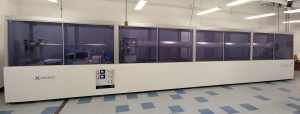Location: LRSM 13
Supervisor/Coordinator: Iryna Golovina
Contact: Iryna Golovina
Phone: 215-573-9482
Email: irynag@upenn.edu
Oversight Committee Chair: Karen I. Winey
 The heart of this facility is a state of the art instrument for ultra-small to wide angle X-ray scattering. The Xeuss 2.0 from Xenocs permits characterization over length scales from 0.09 nm to 600 nm and thus facilitates study of hierarchical structures in a wide range of hard and soft materials. Features and capabilities include:
The heart of this facility is a state of the art instrument for ultra-small to wide angle X-ray scattering. The Xeuss 2.0 from Xenocs permits characterization over length scales from 0.09 nm to 600 nm and thus facilitates study of hierarchical structures in a wide range of hard and soft materials. Features and capabilities include:
The facility is available to Penn faculty, staff, and students, and to outside users on an hourly fee basis.
Non-Penn academic users: $60/hour
Non-academic users: $300/hour or $3000/24-hour day
There is no charge for initial training
DEXS Measurement Service is available at an additional 39% administrative fee to the total cost of service for outside users who are unable to visit the facility directly.
Cutting-edge research at Penn is conducted using DEXS equipment.
For videos, prepared by Paul Heiney, that provide an introduction to modern techniques of X-ray diffraction, please visit the X-Ray Scattering Lecture Series page hosted by the Penn’s Scholarly Commons.


Oversight Committee:
Eric Detsi
Zahra Fakhraai
Paul A. Heiney
Christopher B. Murray
Chinedum Osuji
Eric Stach
Karen I. Winey
Funding for this instrument was provided by a NSF-MRI grant (17-25969), a ARO-DURIP grant (W911NF-17-1-0282), and the University of Pennsylvania.
Facilities users must include the following text in the acknowledgement section of their publications:
“The authors acknowledge use of the Dual Source and Environmental X-ray Scattering facility operated by the Laboratory for Research on the Structure of Matter at the University of Pennsylvania (NSF MRSEC 17-20530). The equipment purchase was made possible by a NSF MRI grant (17-25969), a ARO DURIP grant (W911NF-17-1-0282), and the University of Pennsylvania.”






